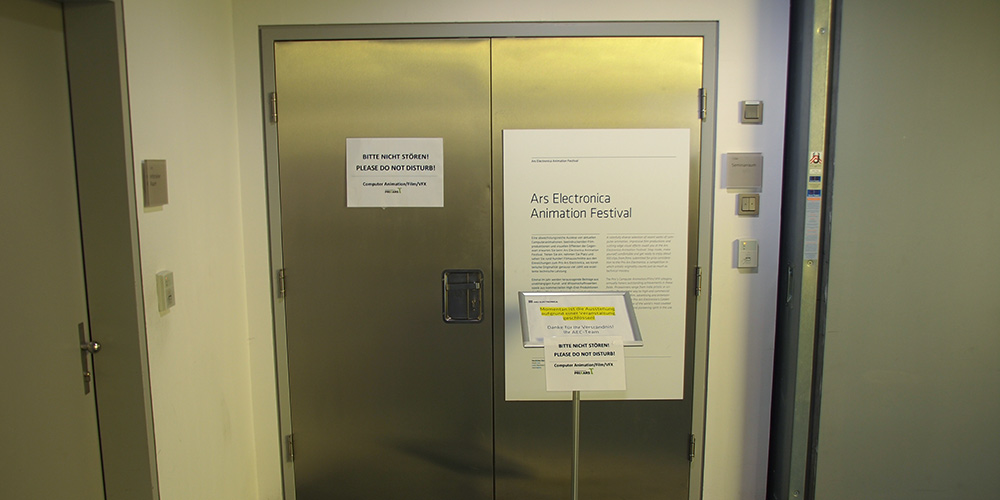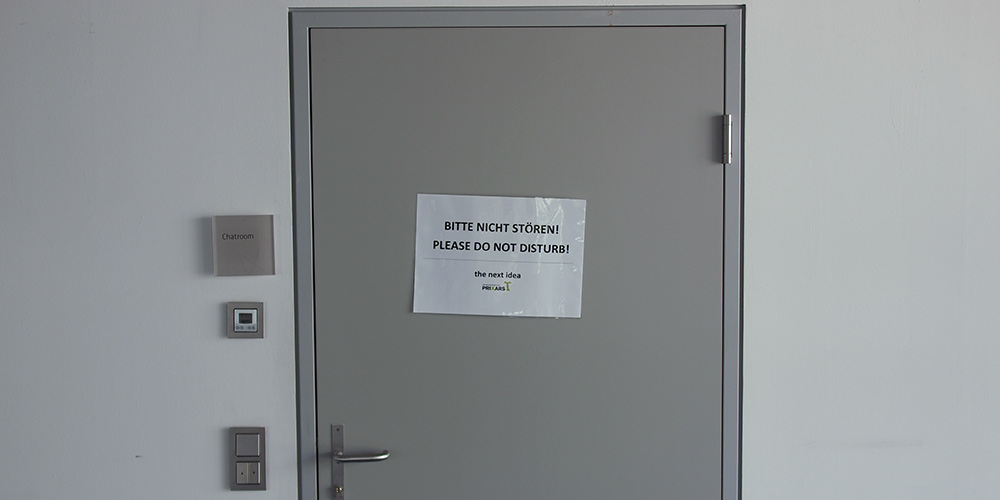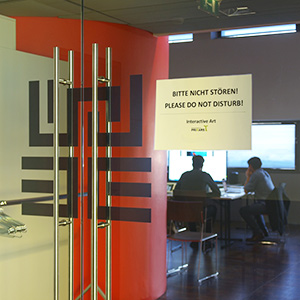
Five rooms are reserved for the jury for the Prix Ars Electronica at the Ars Electronica Center (left) and the Ars Electonica Futurelab (right). Fotos: Martin Hieslmair
This year’s recipients of the Prix Ars Electronica, one of the world’s foremost awards for creativity and pioneering spirit in digital media, will be selected this weekend. Established in 1987, the Prix Ars Electronica has been staged by Ars Electronica Linz for 27 years now. The Prix entry deadline was at the end of March, so we would like to take this opportunity to once again thank all those who submitted projects for prize consideration in a total of six categories.
The juries’ three days of deliberations begin today at the Ars Electronica Center Linz, where the many entries will be viewed and assessed by the jurors. A total of 25 men and women from all over the world have until Sunday to decide who will be singled out for recognition for their excellent work in the respective categories. The Golden Nica grand prizes, Awards of Distinction and Honorary Mentions will be presented to the winners at the Ars Electronica Gala held in conjunction with the Ars Electronica Festival in September.
The categories in the overview
In 2014, Ars Electronica will honor outstanding efforts in six categories. Here’s a brief overview:
Computer Animation / Film / VFX

In the seminar room, the jury of the category “Computer Animation / Film / VFX” takes space on cinema seats – the Ars Electronica Animation Festival must pause this weekend
The Computer Animation / Film / VFX category has been a Prix Ars Electronica mainstay right from the start. It honors excellent independent artistic and scientific works as well as high-end commercial productions in the film, advertising and entertainment industries. In this category, artistic originality counts just as much as technical mastery.
The category’s five jurors will spend this long weekend viewing lots of footage: works of computer animation in 2-D as well as 3-D, digital short films and narratives, character animation, scientific visualizations, commercials, music videos, visual effects, computer game animation and lots more. The very international jury is made up of Suzanne Buchan (CH/UK), Joe Gerhardt (UK), Sabine Hirtes (DE), Jakub Jablonski (PL) and last year’s winner in this category, Davide Quayola (IT/UK).
Interactive Art

The Sky Loft in the third floor of the Ars Electronica Center is reserved for the jury members of the Interactive Art.
Interactive Art takes a wide variety of forms: installations, performances and network projects. The jury focuses on the artistic quality of how the work’s interaction is designed and developed, and looks for a meaningful dialog between the content on one hand and the work’s interaction principles and interfaces on the other. Of particular interest is the sociopolitical relevance of the interaction and how it manifests an inherent potential to expand human beings’ latitude for action. Here, innovative technological concepts are just as welcome as design excellence (usability).
The jurors—Óscar Abril Ascaso (ES), Irini Papadimitriou (GR/UK), Enrique Rivera (CL), Maholo Uchida (JP) and Michel van Dartel (NL)—will be confronted by installations, performances, audience participation projects, network projects and applications of virtual and augmented reality.
Digital Communities

Please do not disturb, is also called in the jury of the Digital Communities in a meeting room of the Ars Electronica Futurelab.
Digital Communities honors innovation that advances human coexistence, that bridges the geographic as well as the gender-based Digital Divide, that helps overcome cultural conflicts, and that promotes cultural diversity as well as the freedom of artistic expression. Digital Communities plays up the political and cultural potential of digital and network-linked systems, and thus directs public attention to a broad spectrum of projects, works of art, programs, initiatives and phenomena in which social and artistic innovation is taking place in, as it were, real time.
In this category, jurors will be evaluating social software, user-generated content & metadata, crowdsourcing & co-creation, citizen participation/citizen journalism, advocacy projects, smart citizen projects, open data/open government projects and much more. The jurors are Ian Banerjee (IN/AT), Laina Greene (SG/US), Leila Nachawati (ES), Salvatore Vanasco (IT/DE) and Kazuhiko Washio (JP).
u19 – Create Your World

On the 4th floor of the Ars Electronica Center, in the Project Space, another meeting room, the jury is talking about the submissions of children and adolescents under 19 years.
This is the Prix Ars Electronica’s category designed to enable young people under 19 years of age to develop and present their concepts and ideas for the world of tomorrow.
Sirikit Amann (AT), a u19 juror of long standing, will be joined this year by Gerhard Funk (AT), Conny Lee (AT), Kirsten Mascher (DE) and Ulrike Schweiger (AT) in assessing a wide array of projects by creative youngsters: acoustic animated films, sound creations, websites and apps, scientific projects and innovative ideas for the future.
[the next idea] Voestalpine Art and Technology Grant

In the Chat Room Ars Electronica Futurelab all is about the category [the next idea]
Ars Electronica and voestalpine annually award a grant, the aim of which is to honor an inspiring, extraordinary, new idea with great future promise, and to help the person who came up with it to develop it further. This could be an artistic or social innovation; technological and scientific approaches have excellent chances. Whatever—this grant is meant to reward efforts to make conceptual leaps, to develop things further, to improve them and take them to the next level.
The jurors in the category [the next idea] Voestalpine Art and Technology Grant Horst Hörtner (AT), Michael Sterrer-Ebenführer (AT) Rikke Frisk (DK) Ela Kagel (DE) and Alexander Mankowsky (DE), are especially looking forward to projects that deal with issues of essential importance to humankind’s future: energy, mobility and access.
Visionary Pioneers of Media Art

Online runs the jury from the “Visionary Pioneers of Media Art” – also look at who is the winner here!
The Prix Ars Electronica’s newest category spotlights those personalities whose artistic creativity and bold experimentation have played a key role in the exciting emergence of media culture. These men and women are the visionaries who have not only laid the foundation for media art as we know it today but also made a major impact on our current social reality with all its forms of communication and cultural techniques.
The first recipient of this extraordinary award will be determined by a very special jury: all the artists who have themselves been singled out for recognition with a Golden Nica since 1987. For this reason, the decision will not yet be reached this weekend. Through and including May 3rd, previous winners have the opportunity to cast their ballot online and to participate in discussions at #VisionaryPioneers
Three days …

Already on Thursday evening, jurors convened for a meet & greet and kickoff dinner in the company of colleagues at Cubus, the Ars Electronica Center’s restaurant. On Friday, exploratory talks and getting down to the matter at hand gets underway in five category. The juries’ sessions will take place in five separate rooms at the Ars Electronica Center Linz. The deliberations are private and confidential. Present in each room are the respective jurors and one or two Ars Electronica staffers assigned to support them in reaching their decisions.
This process takes three whole days, during which the jurors are dealing with the Prix and its framework on almost a ‘round-the-clock basis. Thus, a very thorough decision-making process goes into the selection of the Golden Nica recipients. There are detailed and comprehensive discussions of the entries in order to assure that every project submitted receives the attention it deserves. And even if it ultimately falls short of Golden Nica honors, making it this far in the selection process is itself high praise indeed and strong testimony to the high quality of the work that went into it.
On Sunday afternoon, the juries’ decisions on the recipients of the Golden Nicas and other honors in the respective categories will be presented internally. In each case, the jury must elaborate on the reasoning that went into its decisions. Here as well, the results of the deliberations are themselves often the subject of occasionally quite intense discussions—after all, jurors are very much interested in what transpired in the other categories too!
And so it goes on …
The Prix winners will be announced at a press conference on June 2nd.
The Ars Electronica Gala, the ceremony at which the Golden Nica statuettes, Awards of Distinction and Honorary Mentions are bestowed upon the recipients, will be held during the Ars Electronica Festival in September. The winners of Golden Nicas and Awards of Distinction are also invited to present their projects at one of the Prix Ars Electronica Forums held in conjunction with the Festival.
Plus, a selection works honored by the Prix Ars Electronica will be showcased in the CyberArts Exhibition, one of the highlights of each year’s Festival. Winners of the u19 – Create Your World competition for youngsters will be featured in an exhibition of their own that runs for a year in the Museum of the Future.
Prizewinning works in the Computer Animation / Film / VFX category will also be featured in a lineup specifically dedicated to this genre: the Ars Electronica Animation Festival with Electronic Theatre.
So, exciting times await the Prix Ars Electronica prizewinners in the wake of this jury weekend. And we’re really looking forward to experiencing the works singled out for recognition and reporting on them. Additional info about the jurors is available at https://ars.electronica.art/prix/de/jurorinnen/2014/.
